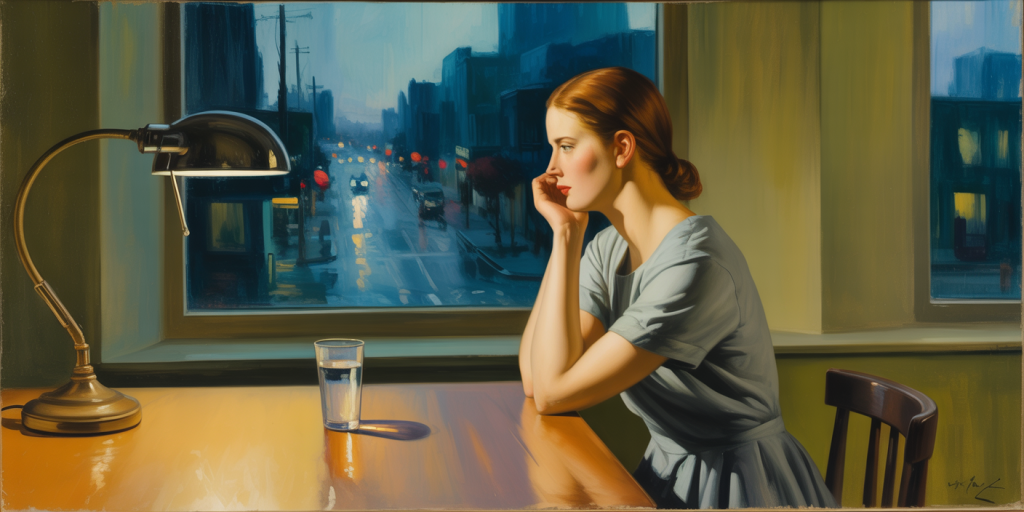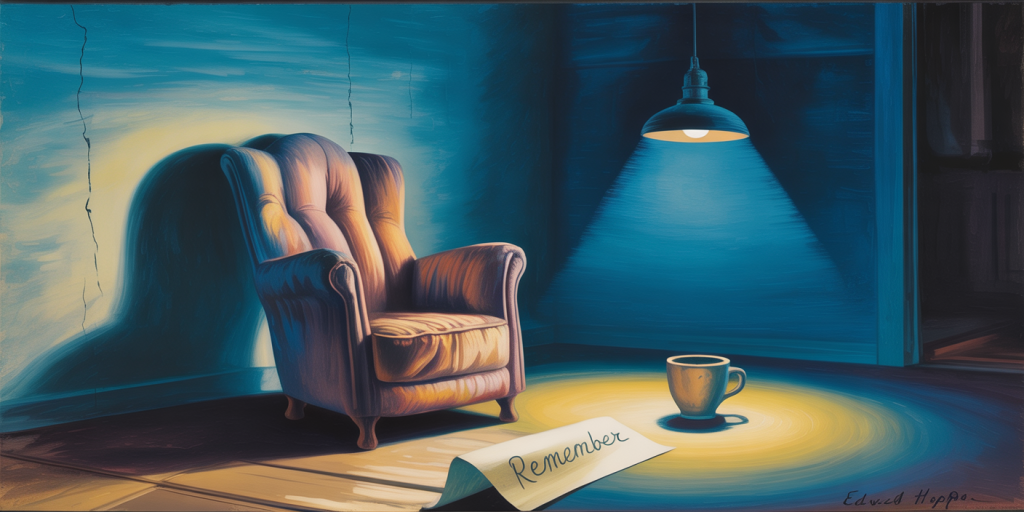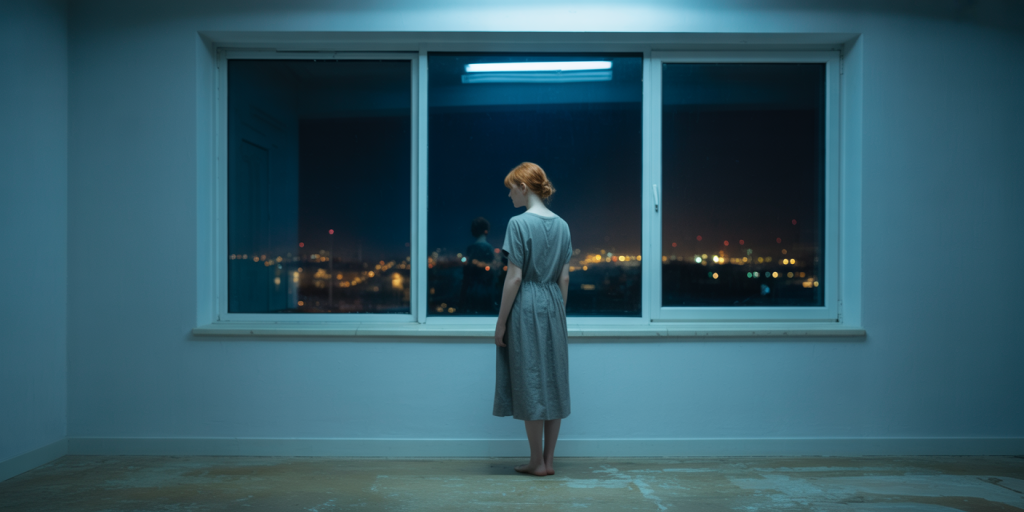Hopper’s Blue Nights and the Loves That Never Return
Contemplative Opening
There are nights that do not fall—they unfold. Edward Hopper painted such nights in layers of melancholy, bathing streets, rooms, and silence in shades of blue no clock could measure. These are not dark nights. They are translucent. Thin enough to see through, heavy enough to press against the soul. They speak not of sleep, but of solitude that glows.
In Hopper’s blue, there is no rage. No farewell. Only the hush of something that once was—still breathing in lamplight, still resting in the shape of a chair, still haunting the mirror of an empty room. His nights do not grieve the loss. They remember its weight.
Table of Contents
- The Blue That Isn’t Sad
- Where Silence Settles
- Geometry of Absence
- The Gaze That Lingers
- Night as Curtain
- Rooms That Refuse to Forget
- The Glow of a Forgotten Window
- Composition in Solitude
- Light Drawn from Memory
- Cold Coffee and Warm Shadows
- The Echo Between Two Chairs
- Waiting Without Expectation
- Distance Across a Table
- The Stillness Behind a Glance
- Lamplight as Companion
- The Skin of the Wall
- The Whisper Beneath the Neon
- A Door Slightly Open
- The Presence of What Left
- What the Night Does Not Say
The Blue That Isn’t Sad
Hopper’s blue is not the hue of sorrow—it is the temperature of quiet. It holds its breath. It does not ask. It does not cry. It lingers like smoke above a snuffed candle, like perfume on a sweater long unworn.
In his paintings, blue becomes a state of being. It spreads across the canvas, thin and heavy, warm and distant. It evokes the emotional memory of touch, not its presence.
Where Silence Settles
Hopper’s interiors are constructed from silence. Not the absence of sound, but the residue of unsaid things. The walls hold conversations paused mid-sentence. A coat hangs in surrender. A woman stares toward the window, not waiting—but remembering how it felt to be waited for.
Silence does not haunt—it rests. And in that stillness, everything aches with softness.
Geometry of Absence
Hopper builds his compositions like rooms for memory. Angles slice across emotion. A diagonal shadow becomes the ghost of movement. Squares and rectangles hold the weight of what once sat, stood, or stayed.
The absence is architectural. It frames the space with longing. What’s missing is the subject. What remains is the story.

The Gaze That Lingers
The eyes in Hopper’s paintings rarely meet ours. They drift sideways, downward, inward. When two figures share the frame, their gazes cross like strangers on a train—close, brief, never touching.
This detachment is not indifference—it is vulnerability. The gaze does not seek the viewer. It seeks memory.
Night as Curtain
Night in Hopper is not background—it is fabric. It drapes over buildings, coats sidewalks, softens the sharp edges of human presence. It is not threatening. It conceals to protect.
His night has folds. Layers. A velvet depth. The blue night does not close the story—it lets it deepen.
Rooms That Refuse to Forget
Each room in Hopper’s world seems to remember someone who once stood there. The corner where a suitcase once rested. The empty bed half-lit. Even the wallpaper holds the scent of absence.
These rooms are not abandoned. They are loyal. They hold loss gently, like a book never closed.
The Glow of a Forgotten Window
Windows in Hopper’s paintings are never just openings—they are characters. They stare. They glow. They reflect not the outside world, but the emotional weather inside. A window lit in blue is both threshold and memory.
Sometimes, the light leaks out. Sometimes, it stays within. But it always remembers.
Composition in Solitude
Hopper composes solitude like a fugue. One note repeated in echo. One shape held in quiet balance against another. His compositions are never empty—they are intentional.
The space between objects is what defines them. The space between people is where the emotion breathes.
Light Drawn from Memory
His light does not shine—it remembers. It is nostalgic. Faint. Soft as breath on glass. A streetlamp, a desk lamp, a strip of neon—all sources become internal. They do not illuminate the scene. They illuminate the feeling.
His brush carries this light like memory: imperfect, but warm.

Cold Coffee and Warm Shadows
A cup left on a table. Coffee untouched. The ceramic still warm, the liquid now cool. Hopper tells stories in the temperature of light. Shadows stretch from the rim of a cup as if carrying the weight of a conversation left behind.
Objects are not props. They are echoes of presence.
The Echo Between Two Chairs
Two chairs in Hopper’s frame are never too close. Never facing. They sit like former lovers—aware, but distant. The space between them is electric. It hums with what might once have been. What still stirs beneath the surface.
The chairs speak in silence. And we understand.
Waiting Without Expectation
No one in Hopper waits for someone who will arrive. They wait as an act of habit. A ritual. A residue. The woman on the bed is not hoping. The man at the counter is not expecting. They are simply suspended.
This waiting becomes timeless. And timelessness becomes grief’s gentle twin.
Distance Across a Table
Hopper often places figures at opposite sides of a table, a room, a gaze. The table becomes more than furniture—it is a metaphor for the chasm between souls.
A table does not divide. It defines what is no longer shared.
The Stillness Behind a Glance
Stillness is not the lack of movement—it is movement held delicately. A man’s hand resting. A woman’s shoulder slightly turned. The glance that almost was.
Hopper’s figures do not move. They hesitate. And that hesitation tells the whole story.
Lamplight as Companion
The lamp in a Hopper painting is never just light—it is company. It casts warmth on otherwise cold scenes. It creates intimacy in the absence of conversation.
Even when a figure sits alone, the lamp is with them. Glowing, listening.
The Skin of the Wall
Walls in Hopper’s paintings have texture. They feel. They hold warmth. They carry light. The skin of the wall glows gently, like memory does when touched. It absorbs the shadows of those who have passed through.
Even the wall remembers how it felt to be leaned on.

The Whisper Beneath the Neon
Neon in Hopper’s work is not loud—it hums. A whisper of color against the blue. It flickers not for attention, but for remembrance. Neon signs, barely legible, become lullabies in the night.
They mark the places where something used to happen.
A Door Slightly Open
A door in Hopper’s paintings is often ajar. Not wide. Not closed. That opening is a suggestion. A possibility. A memory.
Something left. Something might return. But for now, the air moves quietly through the crack.
The Presence of What Left
Every Hopper canvas contains not just what is there, but what has left. An impression in a chair. A shadow that implies absence. A bed barely rumpled.
His paintings are full of ghosts. Not the kind that frighten—but the kind we once kissed.
What the Night Does Not Say
Hopper’s nights say little. They prefer to ask. They leave space for the viewer to wonder. Why is she alone? Why does he not turn? Why is the window open?
But the answers never arrive. They are not needed. The silence is the statement.
FAQ – Frequently Asked Questions
Who was Edward Hopper?
Edward Hopper (1882–1967) was an American realist painter best known for his evocative portrayals of modern American life, characterized by loneliness, stillness, and the psychological weight of everyday spaces.
What does “blue” represent in his work?
Blue in Hopper’s work symbolizes emotional distance, quiet memory, and the kind of longing that is not dramatic but enduring. It evokes stillness rather than sadness.
Did Hopper paint real people or imagined scenes?
Hopper’s work was often composed from imagination, using staged models (frequently his wife, Jo) and invented scenes. Yet, they feel deeply real—because the emotions are.
What is unique about his lighting?
Hopper’s lighting is naturalistic but emotionally charged. It emphasizes silence and emotional isolation. The way he uses light to sculpt solitude is one of his hallmarks.
Why do his paintings feel so cinematic?
Because they hold a suspended moment, like a still from a story. The viewer becomes part of the scene, filling in the past and future from what is held in the present.
Final Reflections – What Remains After the Night
Edward Hopper painted what we lose and still carry. His blue nights are not endings. They are echoes. They whisper of things unfinished, of glances that didn’t last, of hands no longer held. They are not bitter. They are tender.
He gave us images of what it feels like to have loved and to keep loving even when the person is gone. Even when it is ourselves we are missing.
His blue is not about the dark. It’s about what still glows after everything else has dimmed.
